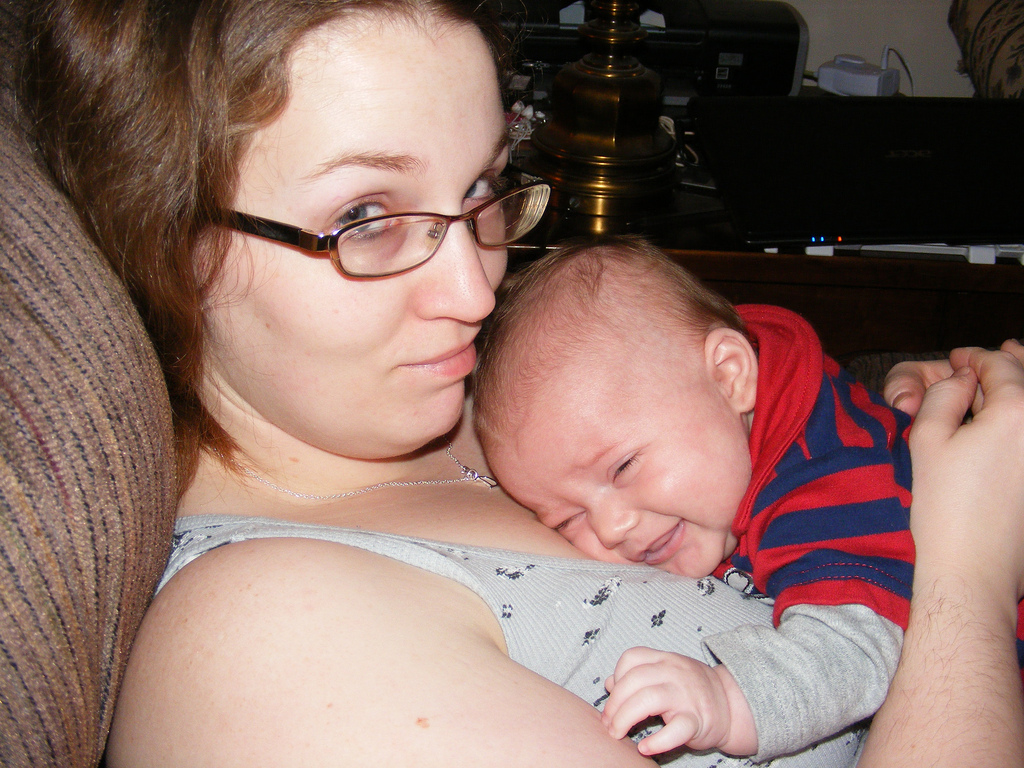Colic Relief: 17 Ways to Calm Colic
Colic stinks.
There’s not too much more I can say about that.
When your baby has colic, you’re willing to try anything and everything to stop the crying and soothe your baby.
Following are 17 soothing techniques you can use right now to provide colic relief.
The Colic Hold
Place your baby face down along your forearm, with her head resting either on your hand, or near your elbow (head on hand only works for little babies). Either way, this will not only give her a change of view, but it also puts gentle pressure on her tummy helping to relieve any tummy pain.
Warm Compress
Try a warm compress on his tummy. You can use either a not-too-hot water bottle wrapped in a towel, or a warm herbal pouch. This can provide some temporary relief if tummy trouble is an issue.
Bounce
Many parents find holding and bouncing their baby, either on an exercise ball, or just standing in place immediately provides relief from colic. This is also a great way to lose those pregnancy pounds. There are even specially designed balls and seats for this purpose (although a regular exercise ball will work too).
Jiggle
Similar to bouncing, try using smaller, quicker movements. Put your baby up high on your shoulder, so her tummy is pressing against the top of your shoulder. Hold on tight, and quickly jiggle her up and down (quickly but not too hard).
Rocking
Rocking your baby in a carseat or infant swing can halt crying instantly. Mild fussing? Try a gentle back and forth motion. Full out crying or screaming? Try rocking faster and harder (highest setting on a swing). Some parents have even found swinging the carseat in a wide arc to work well (make sure your baby is buckled in!). Warning: When using the swing to calm your baby, you may have to settle them before placing them in the swing. Try jiggling or bouncing, and then once they have stopped crying, place them in the swing on the highest setting.
Rolling
Hold your baby so their tummy is resting on top of an exercise ball, and let them gently roll back and forth on the ball. You can also try laying your baby on the floor and gently roll her legs up towards her chest. This can provide some relief if gas pressure is an issue.
White Noise
Use loud, constant noise. This can be a loud ‘shushing’ in your baby’s ear, a vacuum cleaner, a dryer or dishwasher, a fan, or a white noise machine. I highly recommend getting a CD with recorded white noise sounds rather than running your vacuum 24/7! The key with any white noise is volume; of course you don’t want to hurt your baby’s ears, but it does need to be loud. Try turning up the volume gradually until your baby stops crying, and starts to appear sleepy or calm.
Swaddle
Swaddle him. Generally speaking, the snugger the better. Use the swaddle in conjunction with white noise and bouncing or jiggling for even better success. We highly recommend the Miracle Blanket for it’s elasticity and smart, escape-proof design.
Go Outside
Take her outside. Sometimes just being exposed to fresh, cool air can distract a baby enough to stop crying. Often you will need to keep her in constant motion, either carrying her, bouncing her, or pushing her in a stroller. This can be the ideal solution for those colicky evenings. Plan walks during those hours rather than being stuck inside with a screaming baby.
Take a Car Ride
Go for a car ride. Not the ideal solution, especially in the middle of the night. But, if does often calm even the most colicky baby.
Dance
Dance with your baby. It may have to be some pretty wild dancing! Colicky babies often need intense, fast paced movement. Put on your favorite music, strap your baby into a front carrier, and go to town. There are even DVD’s especially for dancing with your fussy baby.
Sucking
Encourage them to suck. If breastfeeding, let your baby feed as often as he wants. Don’t worry about leaving 2-3 hours between feedings. Just be sure you are nursing on the same side to prevent your baby from getting too much watery foremilk. With a formula fed baby, encourage the use of a pacifier or let them suck on your finger. Many babies (even non-colicky ones) cluster feed in the evenings. If your baby is crying in the evenings, it’s always a good idea to offer food.
For more information, see my post Feeding a Fussy Baby.
Warm Bath
Give your baby a warm bath. If your baby tends to cry in the evenings, plan to give her a bath during that time. Sometimes a nice relaxing bath can distract even a colicky baby enough to calm down for a few minutes. If you are having troubles with feeding your baby during their colicky period, try feeding her in the bathtub. Not only will she be getting the skin to skin contact she craves, but she may be relaxed enough to accept the breast or bottle.
Baby Carrier
Carry your baby in a comfortable carrier. It’s not important what you do, as long as you keep moving. Put your baby in the carrier, but don’t expect her to stop crying right away. You will probably have to bounce, walk around, and/or pat her bottom until she becomes calm or falls asleep. Sometimes you may be able to gently take off the carrier and lay her down, asleep. Often though, you will need to keep moving until whatever was bothering her has passed.
Tummy Massage
Gently massage your baby’s tummy, using small circles. You can also try gently pressing down on your baby’s tummy, starting right beneath the sternum, then move your fingers down her middle. This may help release any trapped gas.
Bicycle Motion
Lay your baby on a soft blanket on the floor or sofa, and do some simple exercises to help him release any gas that may be bothering him. Gently press his legs up to his chest, one at a time, in a peddling type movement.
Firm Patting
Hoist your baby up on your shoulder, with her tummy pressed against the top of your shoulder. Pat her on the back or bottom, gently at first. If this gentle patting doesn’t seem to work, try patting her back progressively harder. Some babies may need quite firm patting in order to experience any relief. The combination of the gentle pressure against their tummy, and the rhythmic sound of the patting seems to calm many colicky babies.
For more tips, see my post 40 Fussy Baby Soothing Techniques: The Complete Guide.
What strategies work best for you when it comes to colic relief? What other tips would you add to this list?
Other Posts You May Like
Top 10 Natural Remedies for Colicky Babies
Colic Relief: 17 Ways to Calm Colic
40 Fussy Baby Soothing Techniques: The Complete Guide
Ann’s Story: Not What I Expected
Christine’s Story: Surviving Silent Reflux

